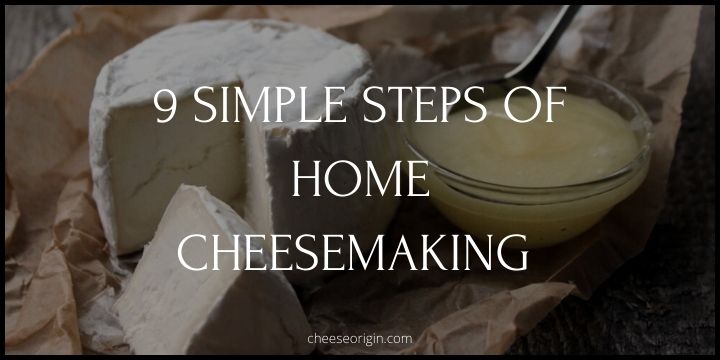9 Simple Steps of Home Cheesemaking (TECHNIQUES)

Cheesemaking is essentially transforming milk into cheese through a series of steps that control its fermentation process.
| Cheesemaking Step # | |
|---|---|
| 1. Warm the Milk | Warming the milk is the first step in the process and it helps to create a conducive and positive environment for the soon-to-be-added cultures. |
| 2. Culture the Milk | Basically, culturing the milk transforms lactose (milk sugar) into lactic acid, and the breakdown of protein structures and fat globules. First process of acidification, proteolysis, and lipolysis. |
| 3. Coagulate | This step is the basis of processing liquid milk to solid. An enzymatic reaction changes the composition of amino acids (casein) in the milk and causes them to stick together, rather than repel. Second process of acidification, proteolysis, and lipolysis. |
| 4. Cut or Ladle the Curd | More curd surface area is exposed, causing whey to escape. Third process of acidification, proteolysis, and lipolysis. |
| 5. Drain the Curds | The curd moisture content decreases as it expels whey. Fourth process of acidification, proteolysis, and lipolysis. |
| 6. Press the Cheese | The cheese curd knits together to form a smooth texture. Fifth process of acidification, proteolysis, and lipolysis. |
| 7. Salt the Cheese | Surface of the cheese dries and the development of rind starts here. Bacterial growth is restricted. Sixth process of acidification, proteolysis, and lipolysis. |
| 8. Dry the Cheese | Rind continues to develop. Seventh process of acidification, proteolysis, and lipolysis. |
| 9. Age the Cheese | The final process of acidification, proteolysis, and lipolysis. |
The Techniques Behind Each Step
1. Warming the Milk
- Place your thermometer in the milk and slowly increase the temperature.
- Remember to stir the milk gently so that it warms evenly.
- Warm the milk as specified in your cheese recipe (usually within 86°F to 90°F)
Tip:
Do not rush this process. Take your time (as you want your milk to be as unadulterated as possible) and you will be rewarded with a flavorful cheese.
2. & 3. Adding Cultures and Coagulate
For many cheese recipes you have to add cultures to the warmed milk before adding the rennet.
When mixing, always use the up and down motion. You want to gently drop and lift your ladle in the stockpot as you move it from side to side.
Doing so will ensure that you are mixing everything into the very depth of the pot and just just the milk on top.
Tip:
When using freeze-dried (powdered), it is advice to sprinkle them and let them hydrate for a minute or so before mixing them into the milk.
Also read: What is Rennet in Cheesemaking?
4. Cut/Ladle the Curd
Knowing when to cut or ladle the curd is a sense that you will naturally develop after a few cheesemaking attempts.
Tip:
The easiest way is to drag your thermometer out by an inch or two. When you see a ‘clean break’ without the curd turning lacy and serrated is when it is ready to be cut.
If the curd does not have a clean break, give it more time to coagulate otherwise your curd will be delicate and waterlogged.
5. Drain the Curds
There are two ways to drain the curds depending on the cheese you are making: over a cheesecloth-lined colander or in forms.
The former is for most soft and spreadable cheeses (some would prefer butter muslin as cheesecloth can be too loosely wooven) while the latter is for most semi-firm and hard cheeses.
When draining, the curds tend to expel whey at a faster rate in the beginning so do take note.
6. Press the Cheese
The purpose of cheese pressing is to expel whey and knit the curd together.
This is a tricky step and your natural instinct should override written directions here.
Always line the form with cheesecloth when pressing a cheese as this will:
- helps the rind from breaking open and
- adds a rustic-looking texture when your cheese is done
Reminder:
Everytime you rotate the cheese between pressings, you’ll need to unwrap the cloth and reline the form.
7. Salt the Cheese
Salt doesn’t just enhance the taste; it also help in preserving your cheese during the aging process. Furthermore, salt helps:
- Development of good rind by drying the curds and controlling moisture
- Kill harmful bacteria, molds and yeasts when used as a brine
Tip:
If you plan to freeze a soft cheese, do not add salt before before freezing.
Recommended Cheese Salt
[amazon box=”B089JJMDMC”]
8. Dry the Cheese
This is another process that requires trial and error in order to master.
It is important to create a drying environment without over-drying the surfaces before rinds develop.
Sounds complicated? I know.
Your best tool is a regular old fan.
Tip:
Do not point your fan directly at the cheese. Instead, create a gentle and indirect airflow through the room.
9. Age the cheese
When it comes to home cheesemaking, owning a wine or a little dorm refrigerator could be a good investment (see below).
Here are a few pointers to keep in mind when refrigerating:
- Temperature: Maintain within 5 degrees of your intended temperature.
- Humidity: Keep your refrigerator within 5% of your intended humidity.
- Airflow: Always keep an eye out for dry rinds. Make sure to have air flow underneath your wheel of cheese. It is recommended to keep resting cheeses on draining mats or cooling racks than putting it straight on the shelf.
- Air exchange: Apart from the previous pointer, you also need new air to enter and old air to leave. The easiest way for a home cheesemaker to do so is to open the door of your refrigerator several times per day to rotate the cheese.
Recommended Wine Refrigerator for Aging Cheese
[amazon box=”B07TDGYPZ6″]
Recommended Wine Refrigerator for Aging Cheese
[amazon box=”B01DZQI70K”]
Temperature Troubleshooting
These are some of the issues that can arise when temperature is not right.
| Procedure | Temperature Too High | Temperature Too Low |
|---|---|---|
| Starter Preparation | Kills active bacteria or makes for very slow acid development | Inhibits bacterial growth. |
| Ripening | Produce a milk that is overly acidic; may kill bacteria | May not be warm enough to allow starter to grow. |
| Renneting | Interferes with starter growth; may decrease rennet activity; at temperatures higher than 130°F, rennet activity virtually ceases. | May result in a curd that takes too long to set and is too soft to cut. |
| Cooking | Scalds the curds, creating a skin that prevents proper drainage. | Interferes with milk’s ability to produce the proper amount of acidity. |
| Aging | Encourages undesirable mold growth and perhaps too rapid an acid development. | Prevents the proper amount of acidity from building up. |
Conclusion
These are the basic techniques for home cheesemaking. Like all other techniques, the best way to master them is to keep practicing.
Articles you might be interested:





